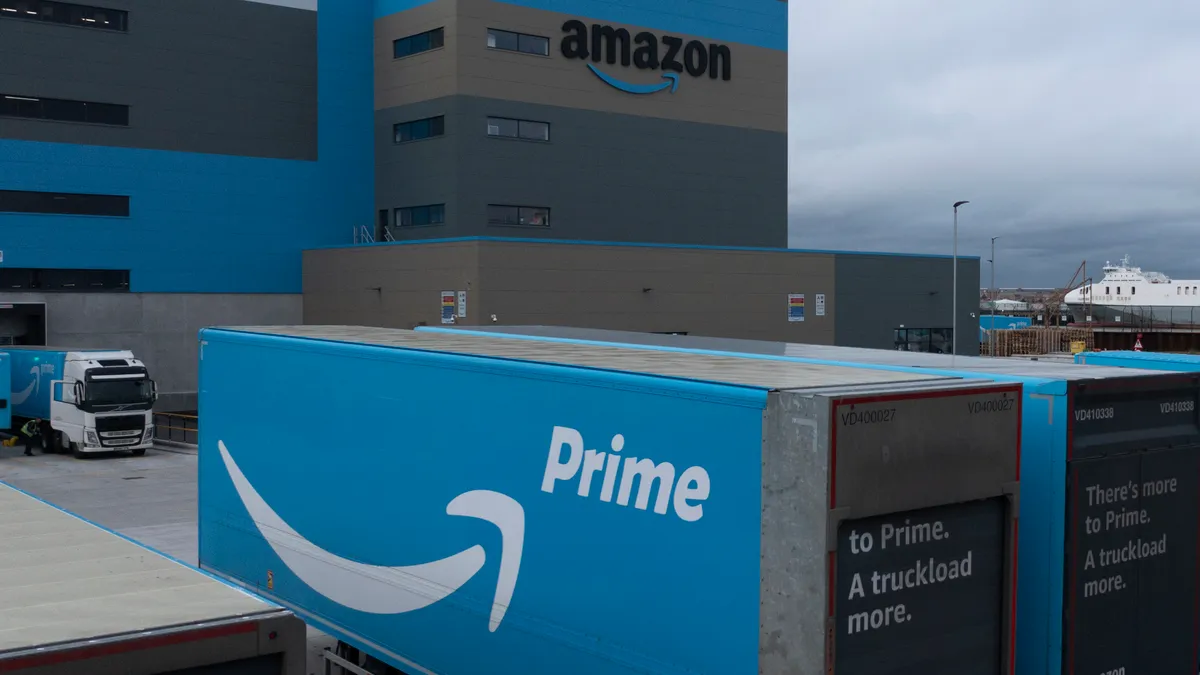Dive Brief:
-
Amazon’s Q1 online retail sales fell 3% year over year to $51.1 billion, while physical store sales rose 17% to $4.6 billion. Net product sales fell 1.8%. Overall company net sales, including its AWS cloud services unit, rose 7% to $116.4 billion.
-
Its e-commerce services posted gains. Marketplace seller fees revenue rose 7% to $25.3 billion, subscription services rose 11% to $8.4 billion and advertising revenue rose 23% to $7.9 billion.
-
The company swung into the red, with a net loss of $3.8 billion, compared with a net income of $8.1 billion in the year-ago quarter, according to a company press release. That included a pre-tax loss of $7.6 billion from its investment in electric vehicle company Rivian Automotive.
Dive Insight:
Amazon Chief Financial Officer Brian Olsavsky on Thursday said the company now boasts "the widest selection ever" for Prime delivery, the swift, free shipping enjoyed by its paying members. Nevertheless, as consumers headed back to stores in the first months of the year, and with inflation taking a bite out of discretionary spending, the e-retailer's product sales took a hit.
While that revenue is down and growth in its retail-related services also slowed, its costs keep rising. The company's total operating expense rose 13.2% to $112.8 billion, including a nearly 23% increase in fulfillment costs. That's in part due to rising costs including labor, cargo and fuel, but also because of excess capacity in the company's fulfillment and transportation network, Olsavsky said.
Along with taking steps to mitigate some of those costs, the company will grow into that capacity, to some extent even this year, he also said. While keeping an eye on inflation, the company is not seeing much hit to demand, according to Olsavsky.
"We'll be really glad we have capacity in Q3 when Prime Day hits, because that's always a big surge of inventory and orders. And then definitely in the holiday season," he said. "The way we see it is, we've come out of a very tumultuous two years. We are glad we made the decisions we made over the past two years. And now we have a chance to do more to rightsize our capacity to a more normalized demand pattern."
The company said that Prime Day will take place in July. To make up for muted sales, there may have to be another one, according to Insider Intelligence principal analyst Andrew Lipsman.
"This was a tough quarter for Amazon with trends across every key area of the business heading in the wrong direction and a weak outlook for Q2," Lipsman said in emailed comments. "Bottom line: Amazon will need to find a way to recharge growth in its commerce business in the coming quarters — don't be surprised if Amazon hosts a second Prime Day this year in October to generate incremental revenues."
The quarter's results underscore how much Amazon's own retail sales have receded compared to the rest of its business, but it remains a robust operation. Olsavsky said the company "added millions more new Prime members during the quarter." Telsey Advisory Group analysts peg that total at about 200 million globally. New initiatives like Buy with Prime, allowing Prime members to leverage their Amazon payment and delivery when buying on other sites, its logistics and growing businesses like its pharmacy offer are "making Amazon more valuable," Telsey analysts led by Joseph Feldman said in Friday research note.
Still, the quarter's challenges set the stage for an uncharacteristically tricky year for the online giant.
"The company remains extremely powerful and has a very attractive business model," GlobalData Managing Director Neil Saunders said in emailed comments. "It is focused on customers and will remain the destination of choice for online shoppers. However, the year ahead will be a more challenging one than Amazon is used to – especially if economic conditions deteriorate further."















